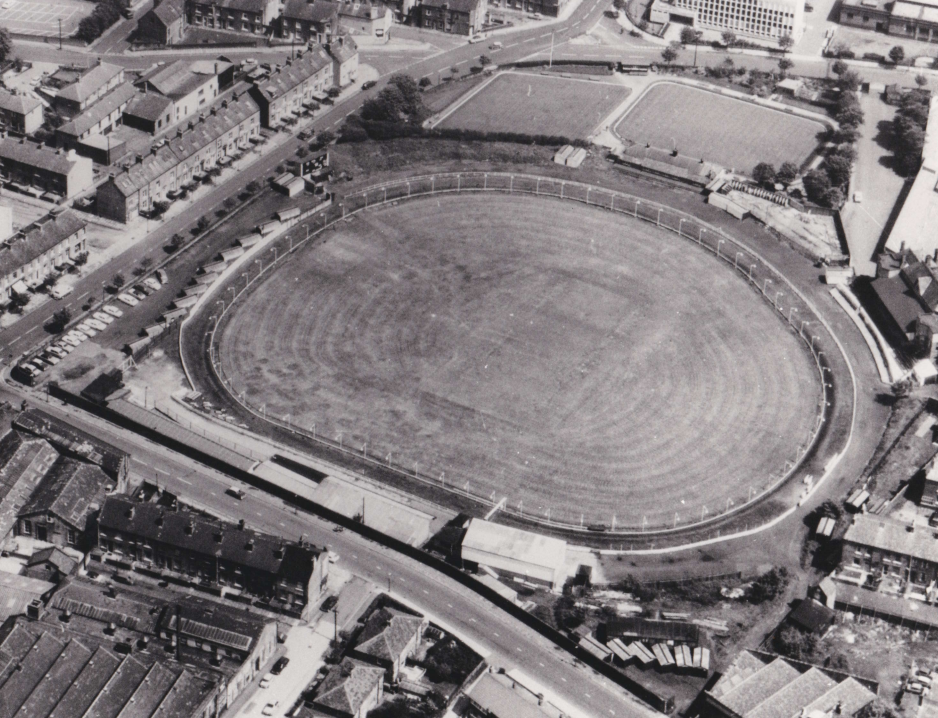Halifax Greyhound Stadium on:
[Wikipedia]
[Google]
[Amazon]
Halifax Greyhound Stadium was a
 It was not until after the
It was not until after the
greyhound racing
Greyhound racing is an organized, competitive sport in which greyhounds are raced around a track. There are two forms of greyhound racing, track racing (normally around an oval track) and coursing; the latter is now banned in most countries. Tr ...
stadium and cricket ground on the same grounds as Thrum Hall
Thrum Hall was a rugby league stadium on Hanson Lane in Halifax, West Yorkshire, England. It was the home of Halifax for 112 years. The site on which the ground stood is now occupied by a supermarket.
History
In 1878, Halifax, who had just w ...
in Halifax, West Yorkshire
Halifax () is a minster and market town in the Metropolitan Borough of Calderdale in West Yorkshire, England. It is the commercial, cultural and administrative centre of the borough, and the headquarters of Calderdale Council. In the 15th cen ...
.
Origins and opening
TheThrum Hall
Thrum Hall was a rugby league stadium on Hanson Lane in Halifax, West Yorkshire, England. It was the home of Halifax for 112 years. The site on which the ground stood is now occupied by a supermarket.
History
In 1878, Halifax, who had just w ...
cricket ground had a speedway
Speedway may refer to:
Racing Race tracks
*Edmonton International Speedway, also known as Speedway Park, a former motor raceway in Edmonton, Alberta
*Indianapolis Motor Speedway, a motor raceway in Speedway, Indiana
Types of races and race cours ...
dirt track constructed around the cricket pitch and hosted the Halifax Speedway team until 1930. A greyhound track replaced the speedway the following year with the greyhound track taking a most unusual shape in the form of a D shape to allow the cricket ground to remain in place inside the circuit.
The first race meeting on Spring Hall Lane was held on 7 November 1931 and the first runner past the winning line was a 4-1 shot called Unconscious. The first distances included 300, 480 and 500 yards (mainly handicaps) and the Manager Director was H.Wood.
History
 It was not until after the
It was not until after the war
War is an intense armed conflict between states, governments, societies, or paramilitary groups such as mercenaries, insurgents, and militias. It is generally characterized by extreme violence, destruction, and mortality, using regular o ...
that the stadium was known as the Halifax Greyhound Stadium and improvements resulted in the venue being able to accommodate between 3,000 and 5,000 spectators during Monday and Thursday racing.
The track remained independent (unaffiliated to a governing body) for 44 years before the move was made to become affiliated with the National Greyhound Racing Club The National Greyhound Racing Club was an organisation that governed Greyhound racing in the United Kingdom.
History
The National Greyhound Racing Club (NGRC) was formed in 1928 and this body would be responsible for regulation, licensing and the ...
(NGRC) in 1975. Facilities by now also included a licensed bar and snack bar, racing was held on Monday and Friday evenings at 7.30pm and trial sessions took place on Sunday mornings. The track was all-grass and race distances of 352 and 490 yards (mainly handicaps) were the featured events.
The change to NGRC racing was under the new permit scheme which enabled smaller tracks to race under rules at reduced costs. No less than six new tracks joined the NGRC permit scheme in 1975 and Halifax owners Jack Wardman and Jon Carter (an Owlerton Stadium
Owlerton Stadium, also known as Sheffield Stadium, is a purpose-built speedway track built in 1929 which also hosts greyhound racing The track is in Owlerton near Hillsborough in Sheffield, South Yorkshire, England. Greyhound racing takes pl ...
director) ensured Halifax became one of them. Wardman introduced a festival of racing in 1975 which attracted some of the North's best dogs.
Just one year later Jon Carter bought a 50% stake in the track with the other 50% being bought by a syndicate of ten that included Barbara Fearn wife of NGRC steward Alan Fearn. In 1978 another change of ownership took place, David Collins a local businessman was the latest buyer and installed photo finish and ray timing for the first time as well as building a new clubhouse for the patrons.
Closure
Despite all of the work from Collins the greyhound racing ceased to run under NGRC rules in 1979. Halifax RLFC sold the site for £1.5 million to Asda in 1998 which now stands in place of the entire sports grounds today.References
{{Motorcycle speedway tracks Defunct greyhound racing venues in the United Kingdom Defunct speedway venues in England